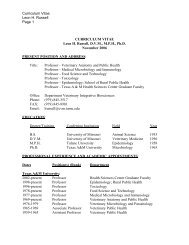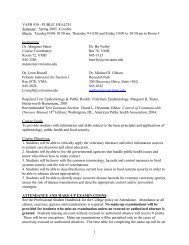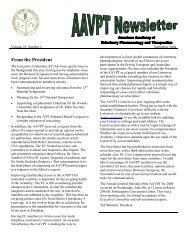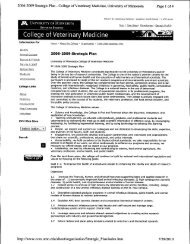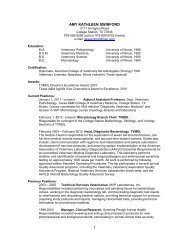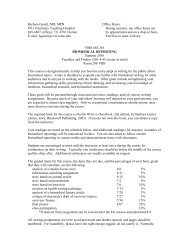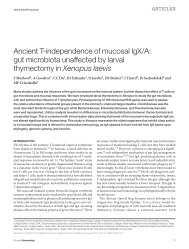View PDF - College of Veterinary Medicine - Texas A&M University
View PDF - College of Veterinary Medicine - Texas A&M University
View PDF - College of Veterinary Medicine - Texas A&M University
You also want an ePaper? Increase the reach of your titles
YUMPU automatically turns print PDFs into web optimized ePapers that Google loves.
12 amino acid Ca 2+ binding loop and is indistinguishable from<br />
EF-hands found in other Ca 2+ sensors. The N-terminal EF-hand,<br />
also referred to as a pseudo or non-canonical EF-hand, contains<br />
a 14 amino acid Ca 2+ binding loop that is unique to S100s<br />
[3]. The pseudo/non-canonical EF-hand is postulated to have<br />
arisen through gene duplication or exon recombination from a<br />
CaM gene with subsequent loss <strong>of</strong> two EF-hands [13]. The term<br />
S100 refers to the solubility <strong>of</strong> the two founding family members,<br />
S100A1 and S100B, in 100% saturated ammonium sulfate<br />
and was used in the early literature to denote a mixture <strong>of</strong><br />
S100A1 and S100B [14]. As new family members were discovered,<br />
the S100 nomenclature evolved, giving rise to numerous aliases<br />
(http://www.genenames.org/genefamilies/S100).<br />
S100 family members exhibit a high degree <strong>of</strong> structural similarity,<br />
but are not functionally interchangeable. With the exception<br />
<strong>of</strong> S100G, which is monomeric, S100 proteins are typically symmetric<br />
dimers [4]. Individual family members exhibit variable affinities<br />
for divalent metal ions (Ca 2+ , Zn 2+ , Cu 2+ ), oligomerization properties,<br />
post-translational modifications, and unique spatial/temporal<br />
expression patterns. S100s bind to and regulate a large number<br />
<strong>of</strong> target proteins, some <strong>of</strong> which are regulated by a single family<br />
member and others by multiple family members. Individual family<br />
members also have different binding orientations for target proteins<br />
that are due in part to differences in surface charge density<br />
[15]. The diversity among S100s, the protein targets that they interact<br />
with, and their cellular distribution allows cells to transduce a<br />
universal Ca 2+ signal into a unique biological response.<br />
The human genome encodes 21 S100 proteins, four <strong>of</strong> which<br />
are singletons dispersed throughout the genome: S100B on chromosome<br />
21, S100G on the X chromosome, S100P on chromosome<br />
4, and S100Z on chromosome 5. Genes for the remaining 17 S100<br />
family members are located in the epidermal differentiation complex<br />
(EDC) on human chromosome 1. The EDC consists <strong>of</strong> over<br />
50 genes within a 2 Mb region that are expressed predominantly<br />
in the skin. The EDC is conserved among humans, rodents, marsupials,<br />
and birds, but not fishes [16]. This region also encodes<br />
the seven S100-fusion type proteins (SFTP), small proline-rich proteins,<br />
cornified envelope proteins, involucrin, and loricrin [17]. The<br />
SFTPs, trichohyalin (TCHH), trichohyalin-like 1 (TCHHL1), repetin<br />
(REPN), hornerin (HRNR), fillagrin (FGL), fillagrin-2 (FGL2), and cornerin<br />
(CRRN), share the same structural organization at the protein<br />
level: a full-length S100 protein domain that is fused in-frame to<br />
differing repeat domains [18]. The S100 protein domain reversibly<br />
binds Ca 2+ and the different repeat domains are believed to function<br />
as intermediate-filament associated proteins or cornified epithelium<br />
proteins. It has been proposed that SFTP genes arose from<br />
the fusion <strong>of</strong> an S100 gene with an epidermal structural gene in<br />
the 1q21 region [19,20]. S100s have been identified in mammals,<br />
birds, reptiles, amphibians, and fish, but not outside <strong>of</strong> the vertebrates.<br />
They are thought to have arisen 460 million years ago<br />
during the Ordovician period long before vertebrates appeared on<br />
land [13,21]. Several S100s are unique to fishes and likely arose<br />
from gene duplication events that occurred after the ray-finned<br />
fish lineage branched from tetrapod lineages [22–25].<br />
This study uses recent whole genome sequencing data from<br />
diverse species to examine the molecular evolution <strong>of</strong> the S100 protein<br />
family in mammals. S100s and SFTPs were in a separate clade<br />
from other Ca 2+ sensor proteins indicating an ancient bifurcation<br />
between these two gene lineages. Furthermore, the five genomic<br />
loci containing S100 genes have remained largely intact in the 165<br />
million years since the shared ancestor <strong>of</strong> egg-laying and placental<br />
mammals. Nonetheless, interesting births and deaths <strong>of</strong> S100<br />
genes have occurred during mammalian evolution. The S100A7 loci<br />
exhibited the most plasticity and phylogenetic analyses clarified<br />
relationships between the S100A7 proteins encoded in the various<br />
mammalian genomes. Phylogenetic analyses also identified four<br />
D.B. Zimmer et al. / Cell Calcium 53 (2013) 170– 179 171<br />
conserved subgroups that predate the rise <strong>of</strong> warm-blooded vertebrates:<br />
A2/A3/A4/A5/A6, A1/A10/A11/B/P/Z, A13/A14/A16, and<br />
A7s/A8/A9/A12/G. The similarity between genomic location and<br />
phylogenetic clades suggests that the subgroups arose by tandem<br />
gene duplication events. Examination <strong>of</strong> annotated S100s in lower<br />
mammals suggests that the ancestral S100 was a member <strong>of</strong> the<br />
A1/A10/A11/B/P/Z subgroup and arose near the emergence <strong>of</strong> vertebrates<br />
approximately 500 million years ago. Additional genomic<br />
and transcriptomic resources will be required to clarify the earliest<br />
natural history <strong>of</strong> this extraordinary family <strong>of</strong> signaling molecules.<br />
2. Methods<br />
2.1. Identification <strong>of</strong> S100s<br />
A stepwise approach was used to identify coding sequences<br />
for the mammalian S100 genes. Keyword searches collecting all<br />
annotated S100s in the National Center for Biotechnological Information<br />
(NCBI) and Ensembl databases were followed by BLAST<br />
searches <strong>of</strong> the GenBank nonredundant protein and expressed<br />
sequence tag (EST) databases to retrieve other S100 family members<br />
using mouse and human sequences as query. For opossum,<br />
platypus, and lizard, the Ensembl database was used extensively.<br />
Other sequences in these species were obtained from EST searches<br />
in NCBI. Out <strong>of</strong> the four lamprey S100 sequences, three were<br />
published [21] but not available in any database, and the fourth<br />
sequence was found in the EST searches. The Xenopus sequences<br />
were obtained by BLAST searches using mouse, human and frog<br />
sequences as query as has been described [26].<br />
2.2. Evolutionary distances<br />
Open reading frame and amino acid alignments <strong>of</strong> S100<br />
homologs were initially made in Bioedit (http://www.mbio.<br />
ncsu.edu/bioedit/bioedit.html) with ClustalW employing gap<br />
opening penalties <strong>of</strong> 10 and gap extension penalties <strong>of</strong> 0.1 for<br />
pairwise alignments, then 0.2 for multiple alignments and the<br />
protein-weighting matrix <strong>of</strong> Gonnett and Blossum [27,28]. These<br />
alignments were then further modified after visual inspection.<br />
MEGA5 [29] was used to infer the phylogenetic relationships <strong>of</strong><br />
S100 and related Ca 2+ sensors. Distance matrices were computed<br />
for nucleotide alignments using the Maximum Composite Likelihood<br />
method and for amino acids using a Dayh<strong>of</strong>f matrix based<br />
method [30]. Accession numbers <strong>of</strong> sequences used in these analyses<br />
are provided in Supplemental Tables 1 and 2.<br />
2.3. Phylogenetic analyses<br />
MEGA5 was used to construct phylogenetic trees. All three<br />
codon positions <strong>of</strong> nucleotide data were included in the analyses:<br />
1290 nucleotide positions total for the human Ca 2+ sensor analysis<br />
and 1056 for the mouse Ca 2+ sensor analysis. Representative genes<br />
were included in the mouse and human trees to represent major<br />
families and produce the most meaningful phylogeny. For the panmammalian<br />
S100 analysis, 135 amino acids columns were used. An<br />
outgroup was not specified in the pan-mammalian analysis due to<br />
the unclear orthology <strong>of</strong> potential lower vertebrate sequences. The<br />
evolutionary histories were inferred using the Neighbor-Joining<br />
method as has been previously described [31]. The percentage <strong>of</strong><br />
replicate trees in which the associated taxa clustered together in<br />
the bootstrap test (1000 replicates) are shown next to the branches<br />
[32]. Trees were viewed using the Treeview s<strong>of</strong>tware [33].




